レポート

China’s luxury goods market is humming along nicely, with a second straight year of 20% growth in 2018 (see Figure 1). Think of it as a powerful machine running on four engines operating in perfect alignment.
The domestic luxury market posted 20% growth in 2018, driven by millennials and women
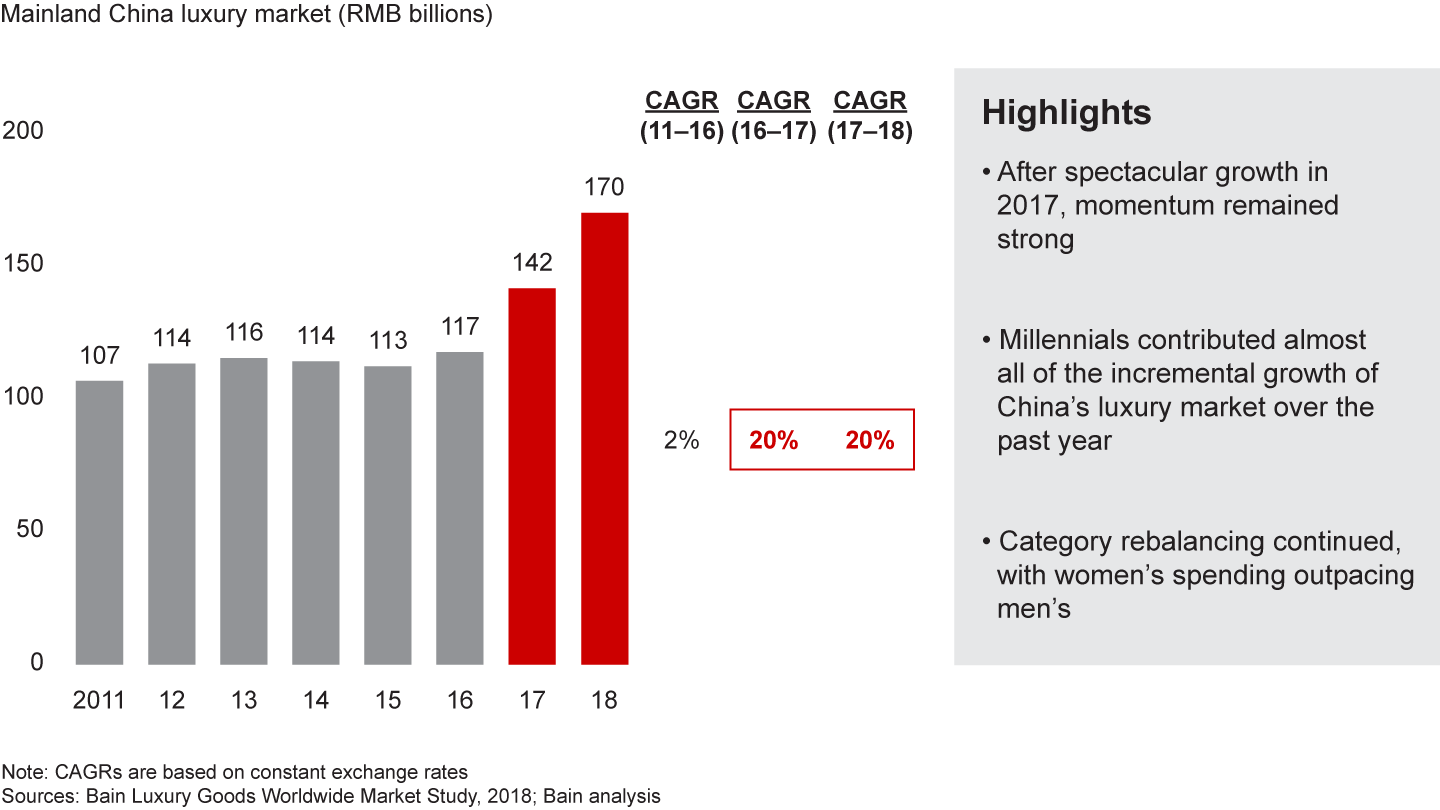
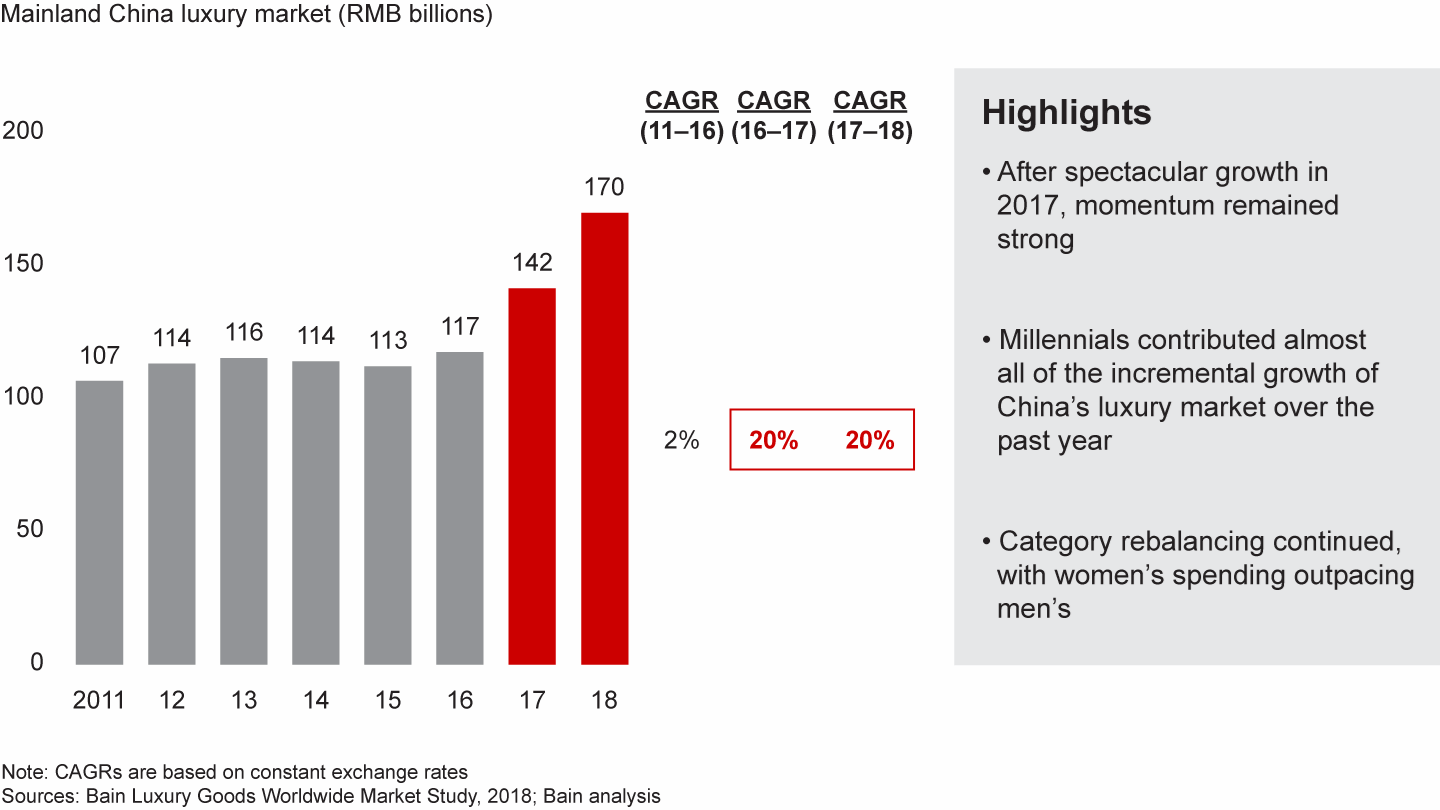
Engine 1: Repatriation
The Chinese government’s reduction in import duties and stricter controls over gray markets—combined with brands’ efforts to narrow the price gap with overseas markets—have led more Chinese consumers to make their luxury purchases in China, instead of traveling to previous bargain locales such as Hong Kong, Seoul, Tokyo and cities in Europe. Chinese consumers made 27% of their luxury purchases in China in 2018, up from 23% in 2015, and we anticipate that this share will increase to 50% by 2025 (see Figure 2). But this doesn’t mean that Chinese consumers are buying less abroad. Luxury spending by Chinese shoppers now represents 33% of the global market (see Figure 3).
The repatriation of spending will continue in the coming years
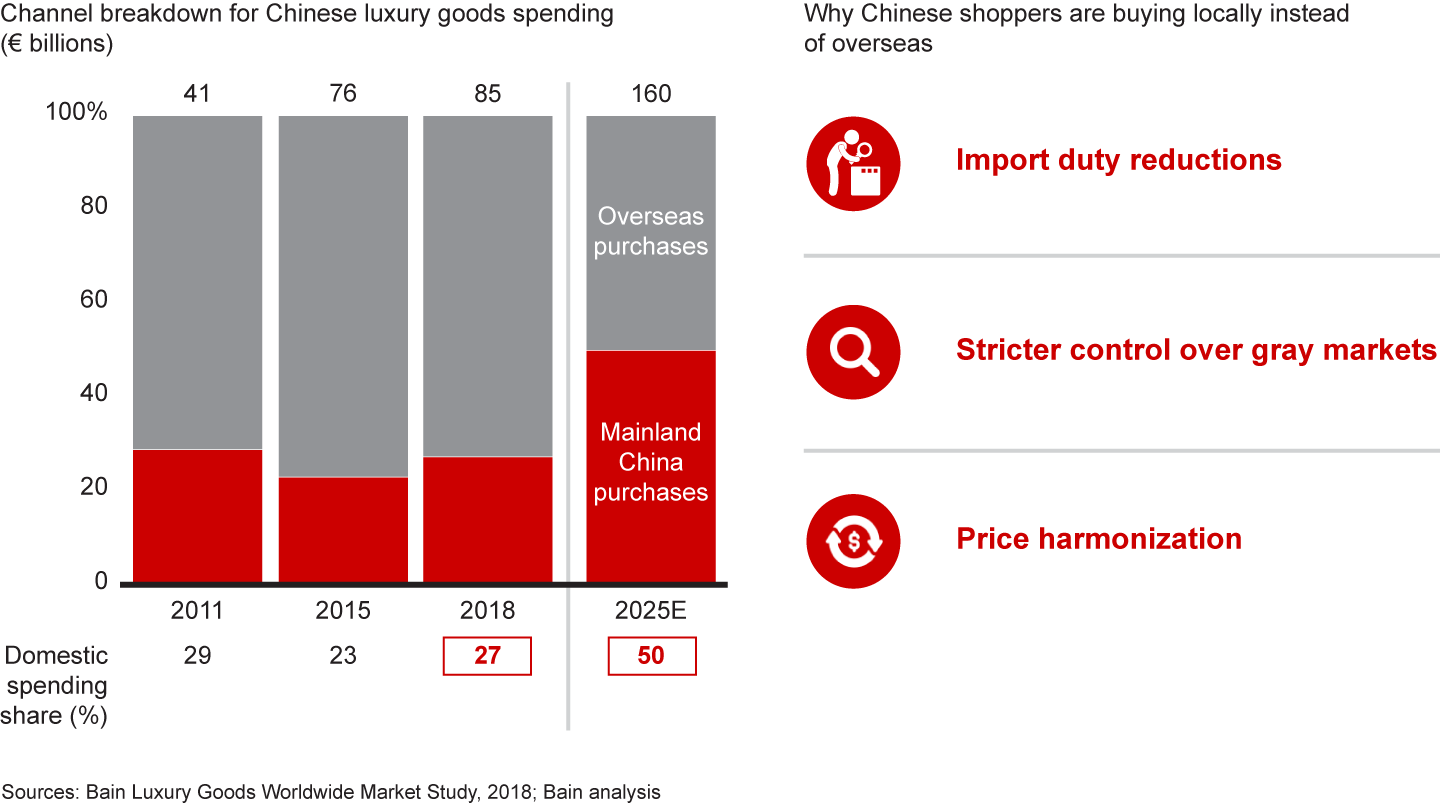
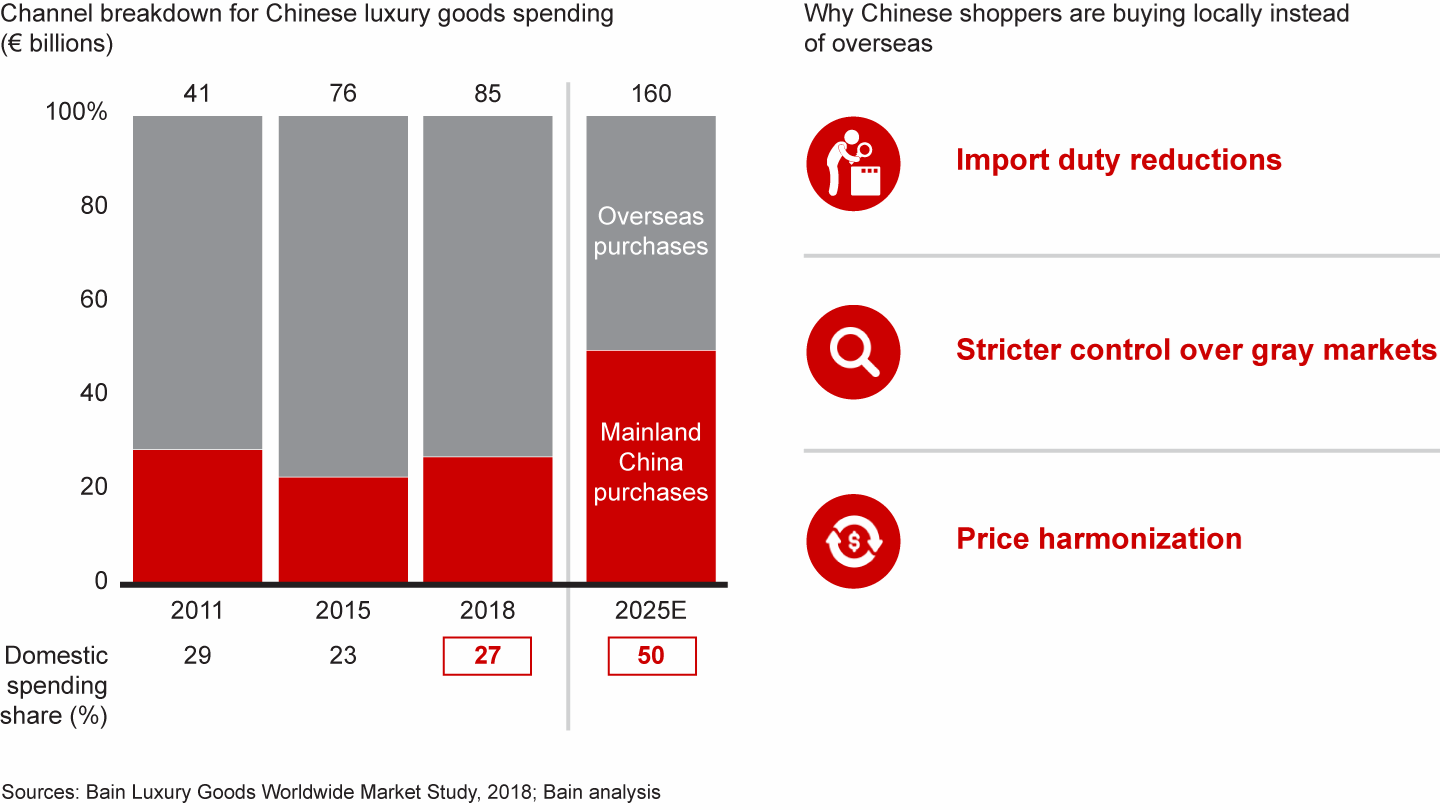
Chinese spending represented 33% of the global luxury market in 2018
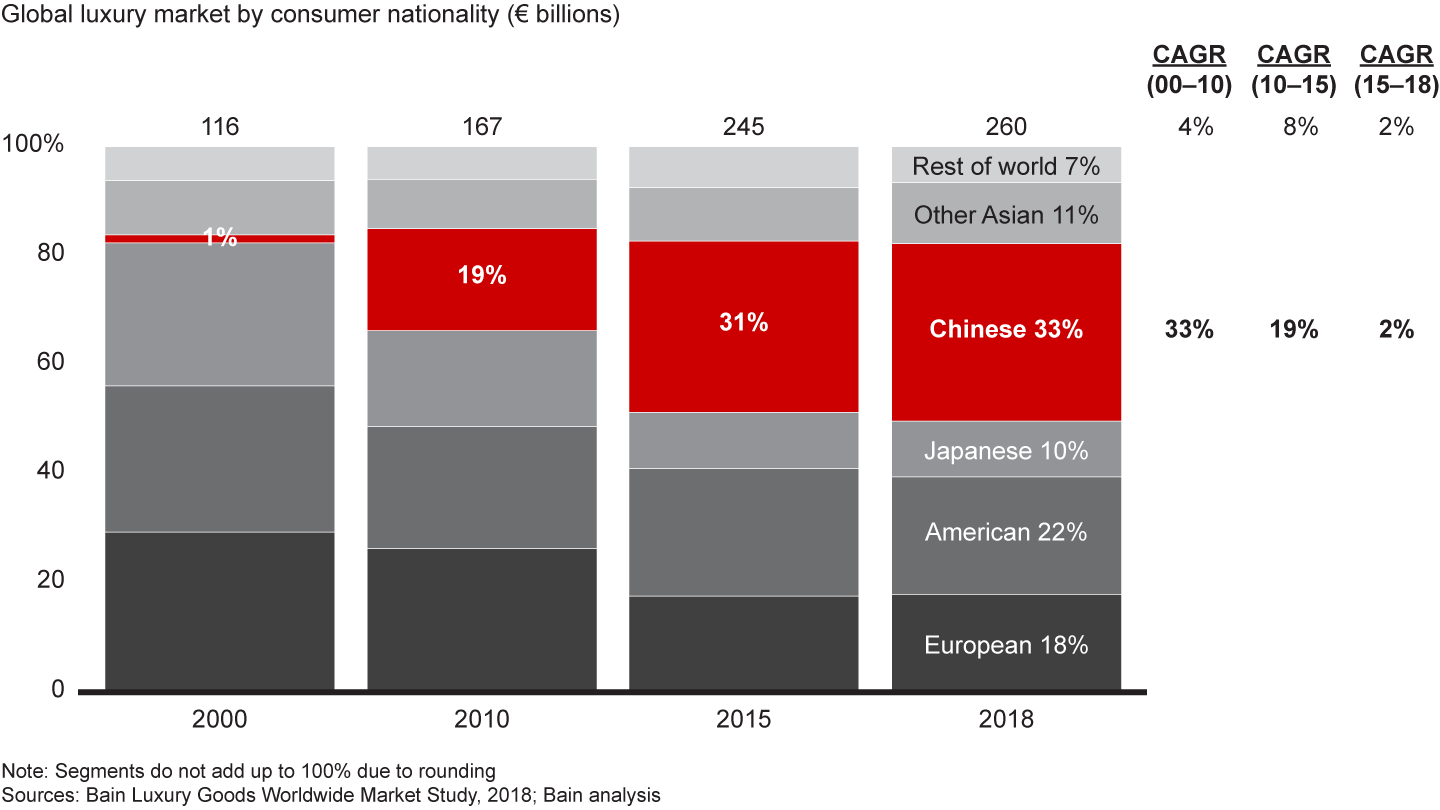
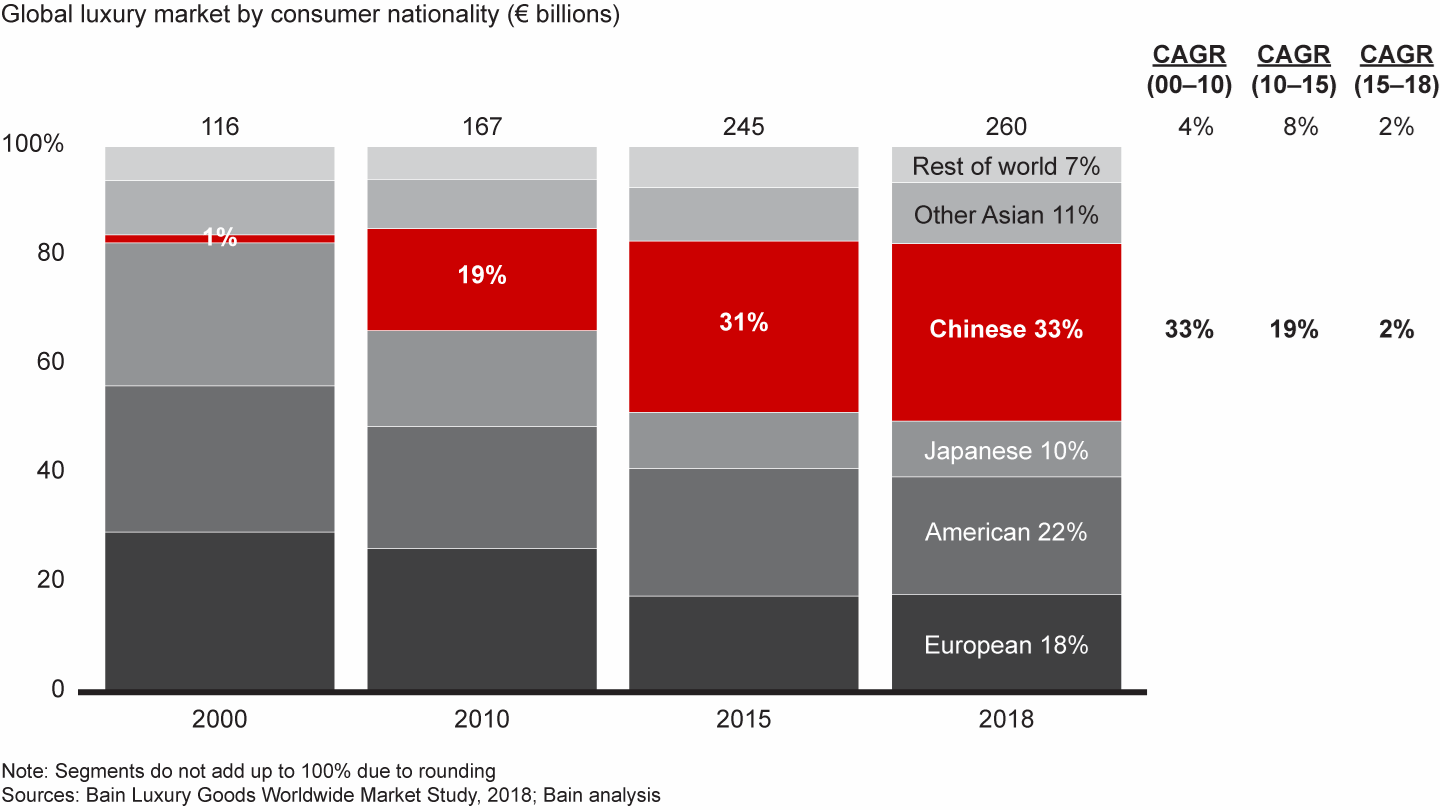
Engine 2: Millennials
Consumers aged 23 to 38 are willing to spend on luxury brands, and financially able to do so. Fully 70% of China’s millennials own their own homes—twice the rate of US millennials, according to HSBC’s Beyond the Bricks study (see Figure 4). And they can get funding from their parents if they want to buy luxury goods. Moreover, these young consumers are well informed about luxury and eager to embrace innovative trends, such as the convergence of high fashion and sportswear. Millennials are the big market for luxury sportswear products like Balenciaga’s Triple S sneaker, which was introduced in 2017 and maintained its popularity throughout 2018, and accessories cocreated by Louis Vuitton and Supreme, a fashion brand with roots in skateboarding.
Chinese millennials are financially able to spend on luxury brands
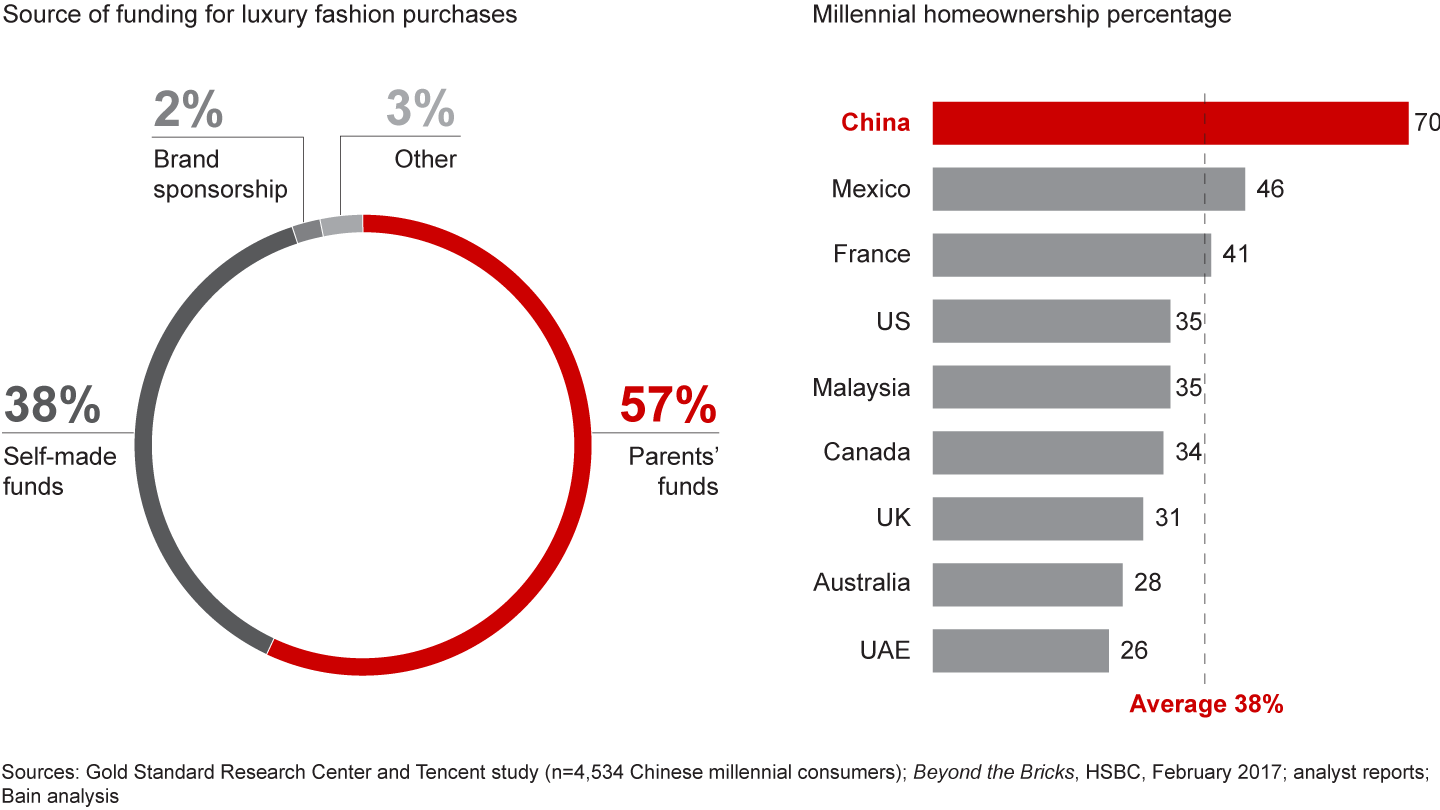
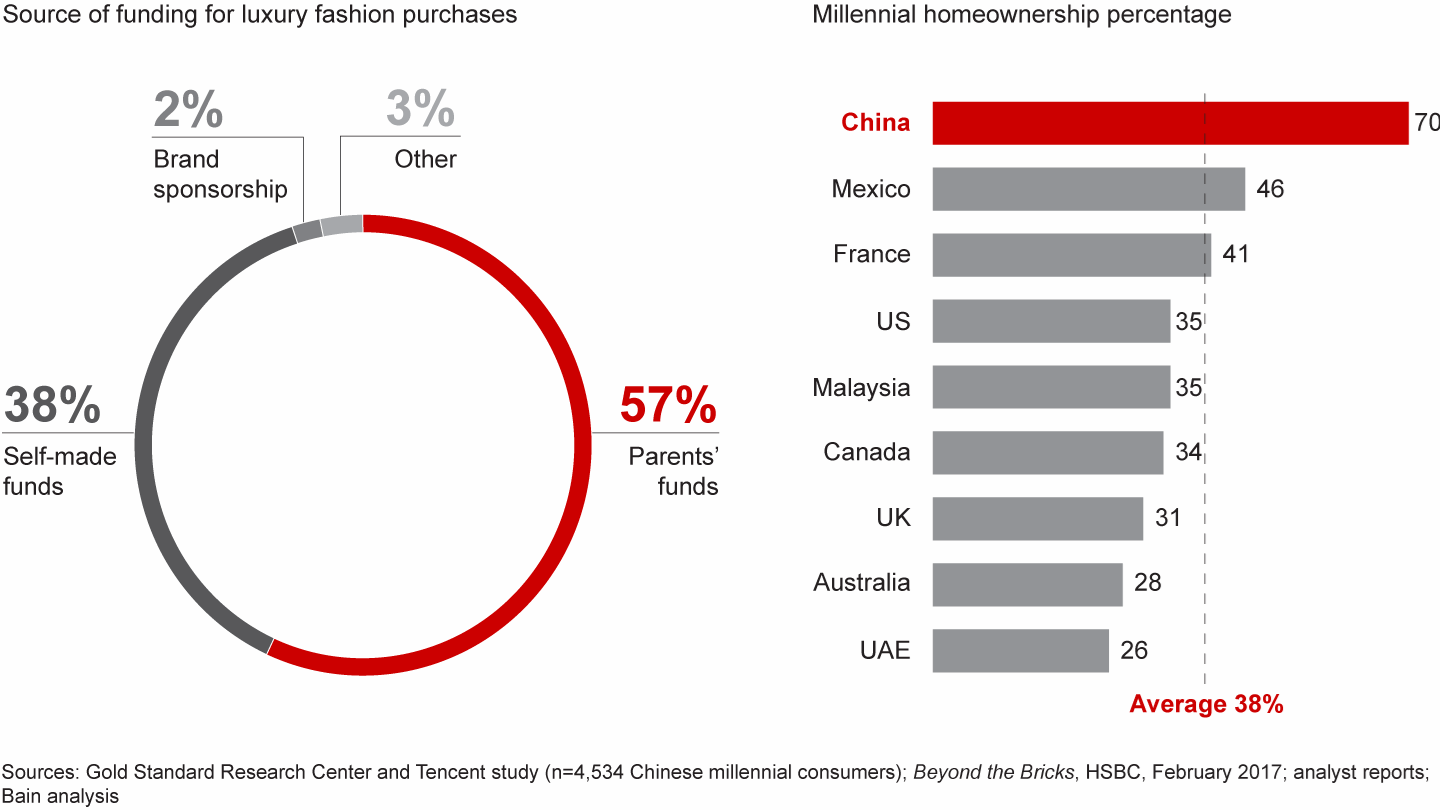
Unlike older generations, millennials are more heavily influenced by what they consider to be cool than by brand names or product pricing. They value newness more than discounts. They rely on social media and freely share their opinions online. Like their counterparts in all age groups, millennial women buy more luxury goods than men do. Cosmetics, a traditionally female category, grew by more than 25% in 2018, for example, while watches, a predominantly male category, grew by less than 10%.
Engine 3: Digitalization
The third engine powering luxury sales in China, digitalization covers both e-commerce and consumer engagement through digital platforms. There has been much progress in terms of engaging customers, but little progress on the e-commerce front (despite plenty of activity). Online luxury sales increased by 27% in 2018 to reach 10% of total luxury sales (see Figure 5), but this growth is still driven by cosmetics, while online penetration in other categories remains very low.
Online luxury sales outgrew the overall market in 2018, but online penetration remains low—except in cosmetics
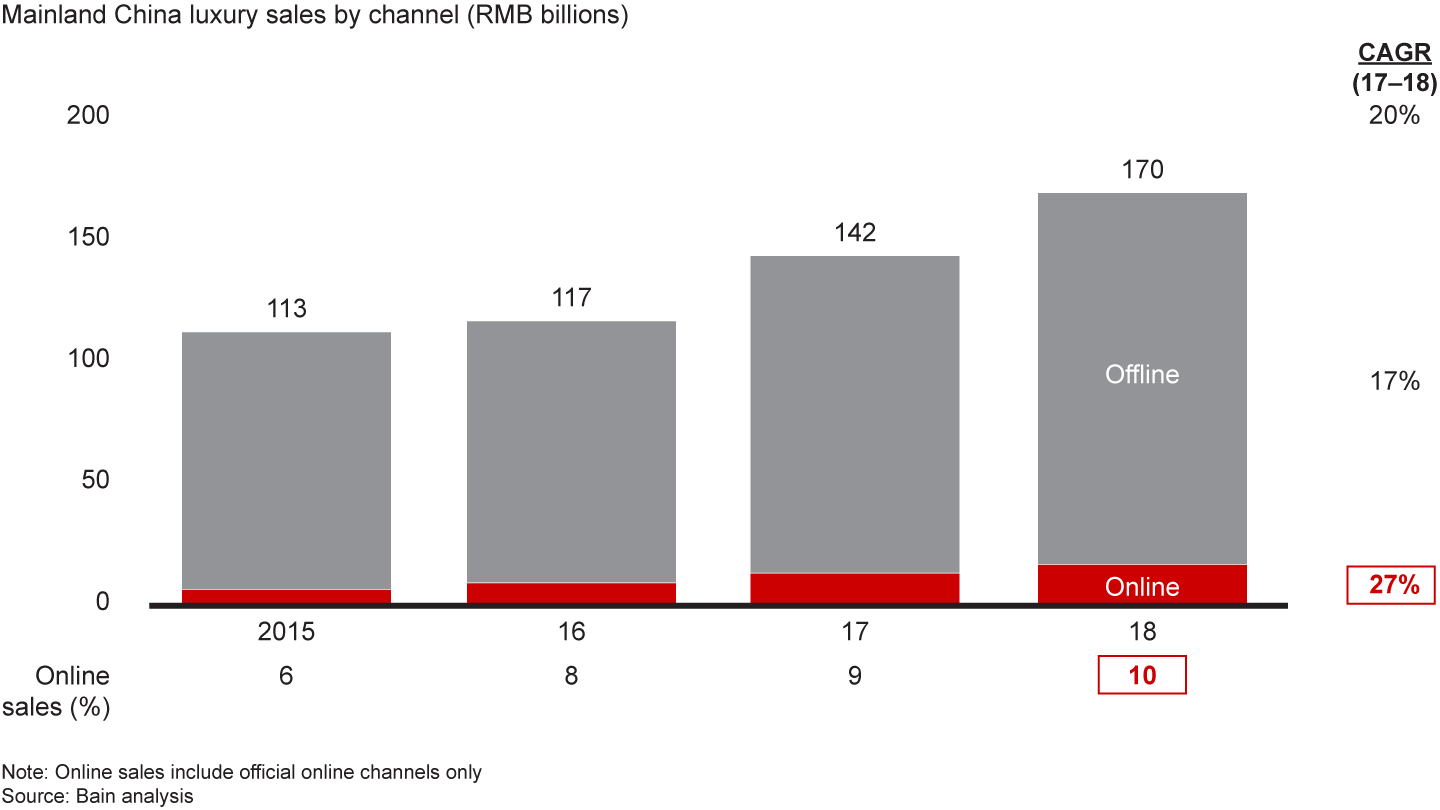
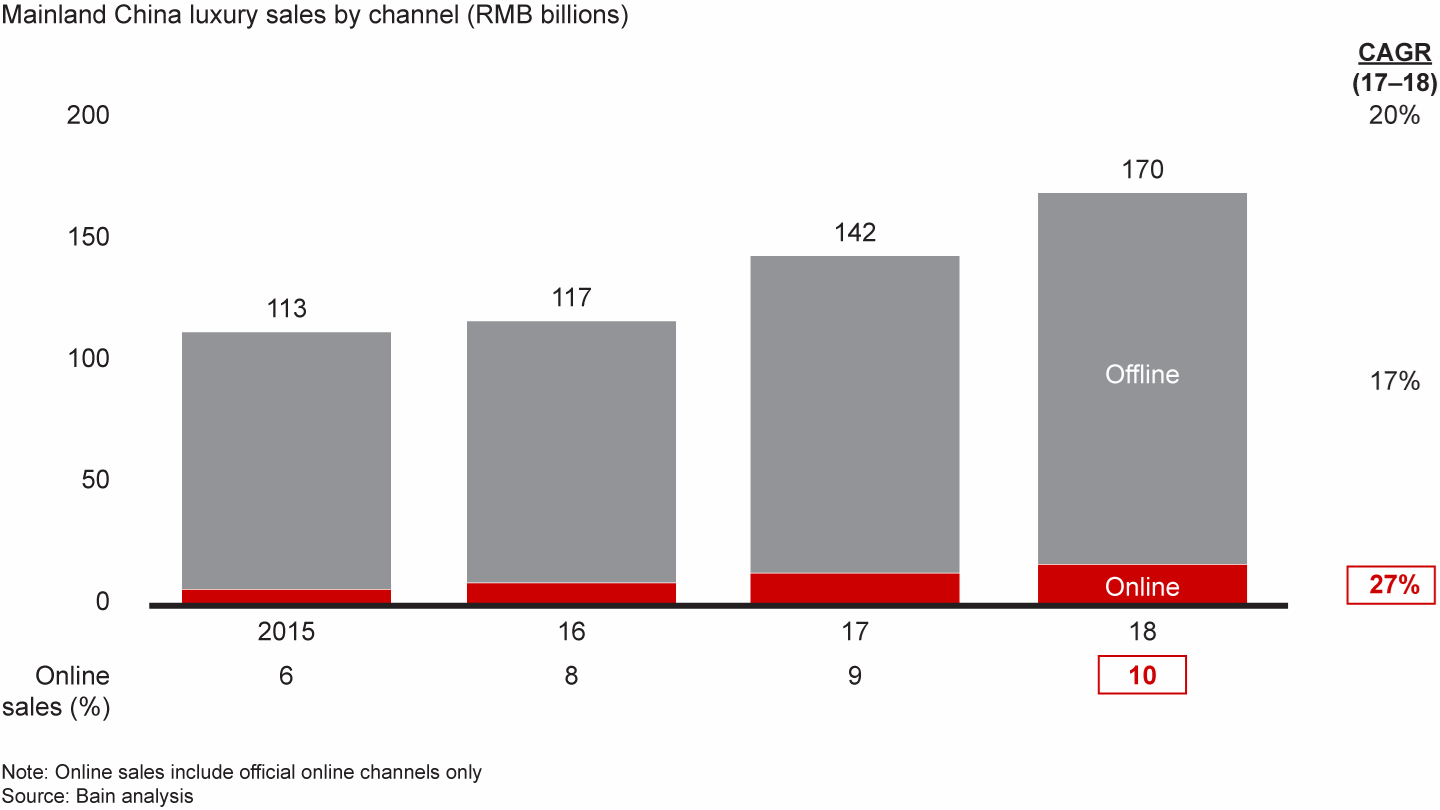
Four types of online channels have been active in the domestic luxury market (see Figure 6). Brand-owned channels like Hermes.com.cn—we refer to them as “brand.com”—give companies ultimate control and the ability to charge full price. Cooperator channels like Tmall flagship stores and WeChat commerce give brands some control while allowing them to benefit from the platform’s steady flow of traffic. Aggregators such as JD.com’s Toplife and Tmall’s Luxury Pavilion enable brands to outsource the responsibility of building and operating high-traffic channels. Finally, luxury vertical sites such as Secoo and Mei.com make it possible to move goods at a discount.
Four types of online channels were active in the domestic luxury market
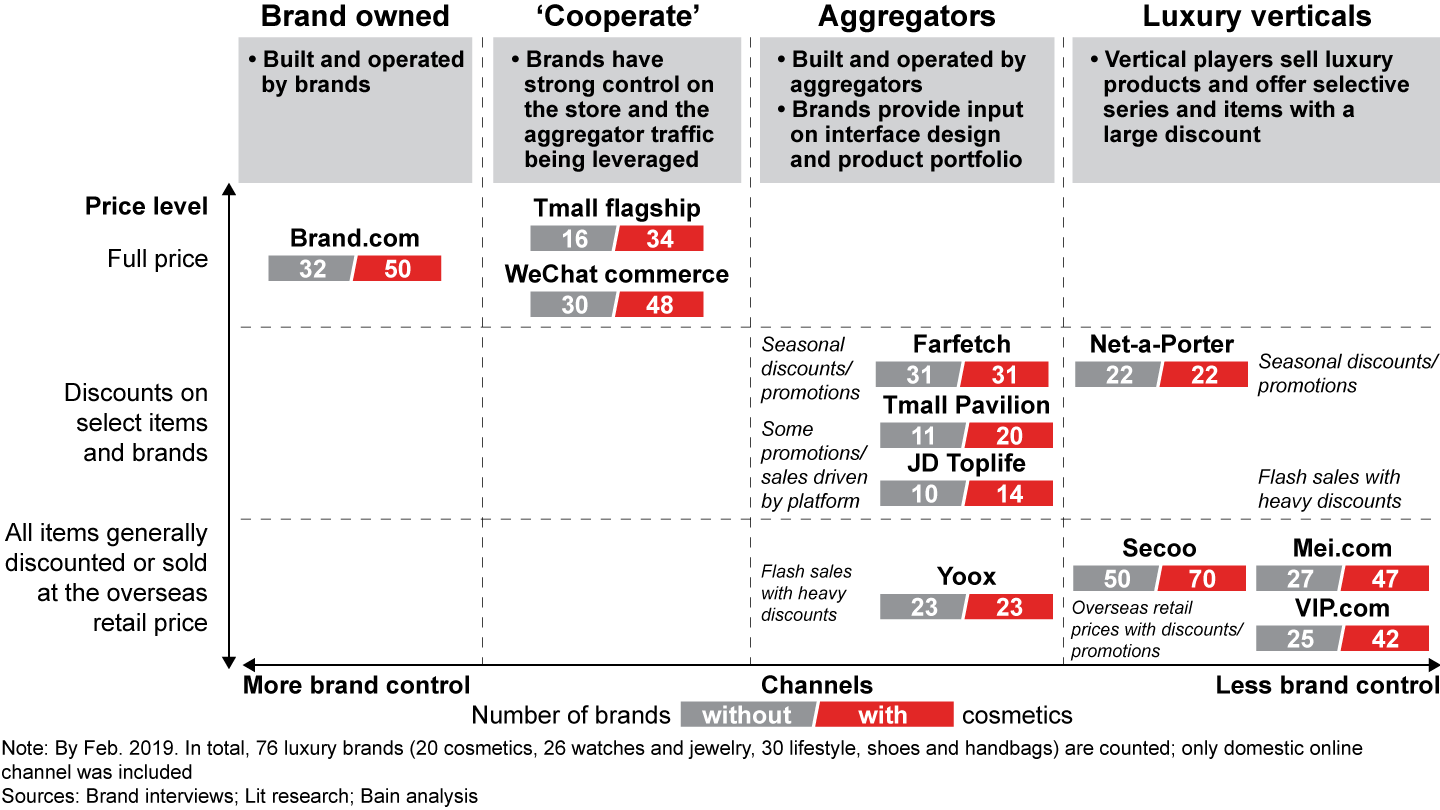
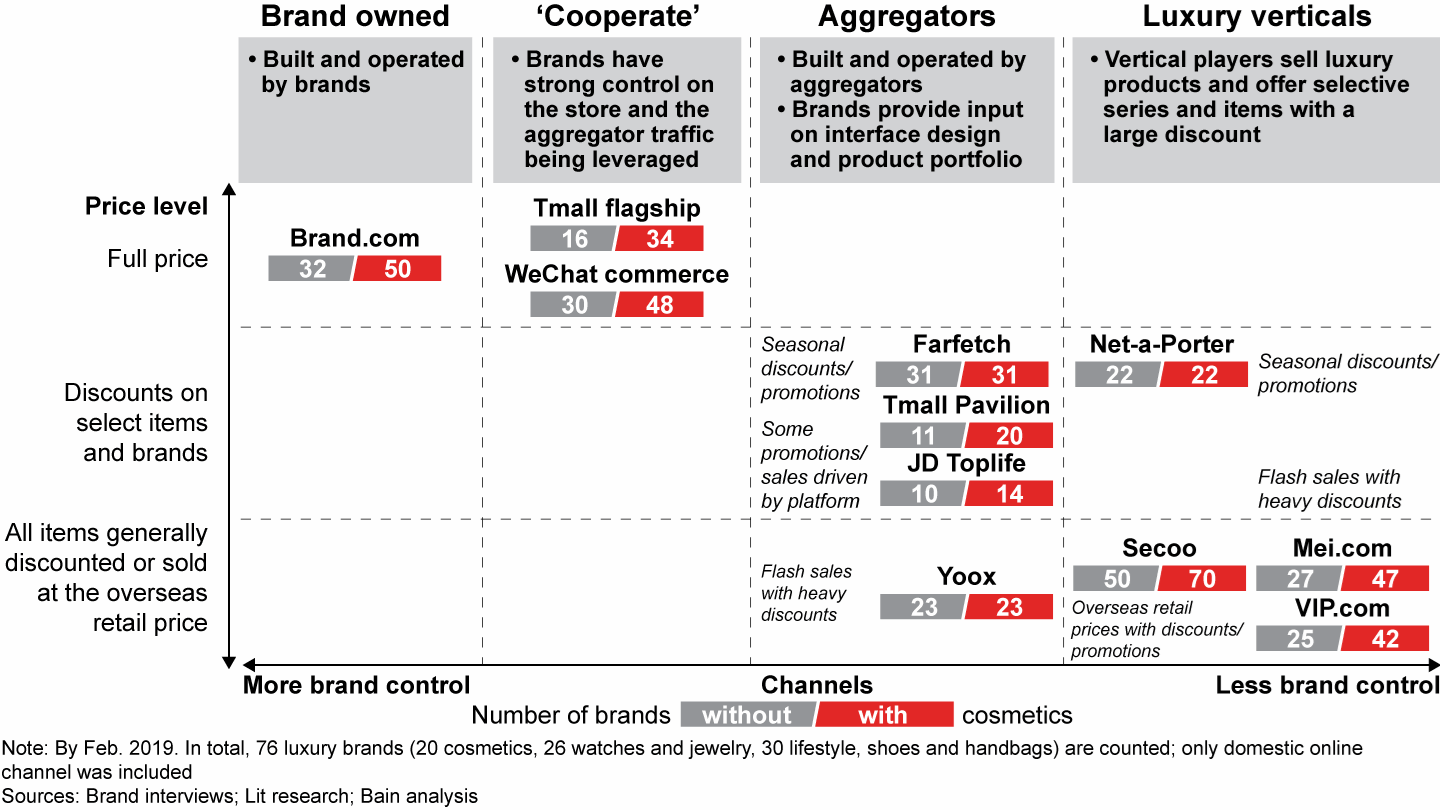
In 2018, more brands looked for ways to expand their online presence through collaborations with leading e-commerce platforms, while others maintained a focus on their brand.com.
It was also a year of heavy deal activity, including the following highlights:
- JD.com and L Catterton’s $175 million investment in Secoo
- Richemont’s acquisition of Yoox Net-a-Porter (YNAP)
- YNAP’s strategic partnership with Alibaba Group
- The merger of JD.com’s Toplife with Farfetch
As a result of this intense dealmaking, we see three types of ecosystems emerging: those centered around a brand.com and those built in collaboration with either Alibaba Group or JD.com (see Figure 7).
Recent deals among online platforms have led to the emergence of three online ecosystems for luxury brands in China
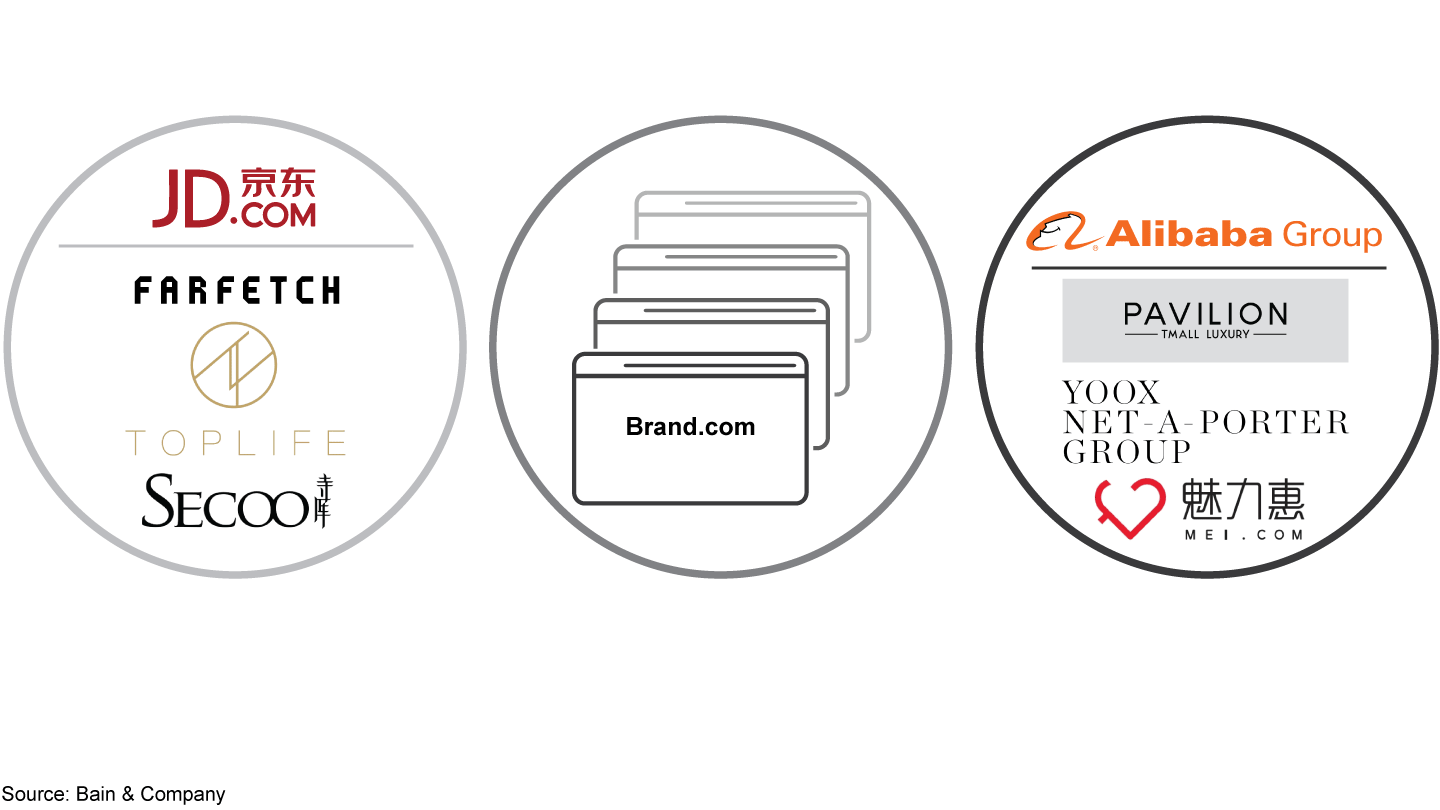
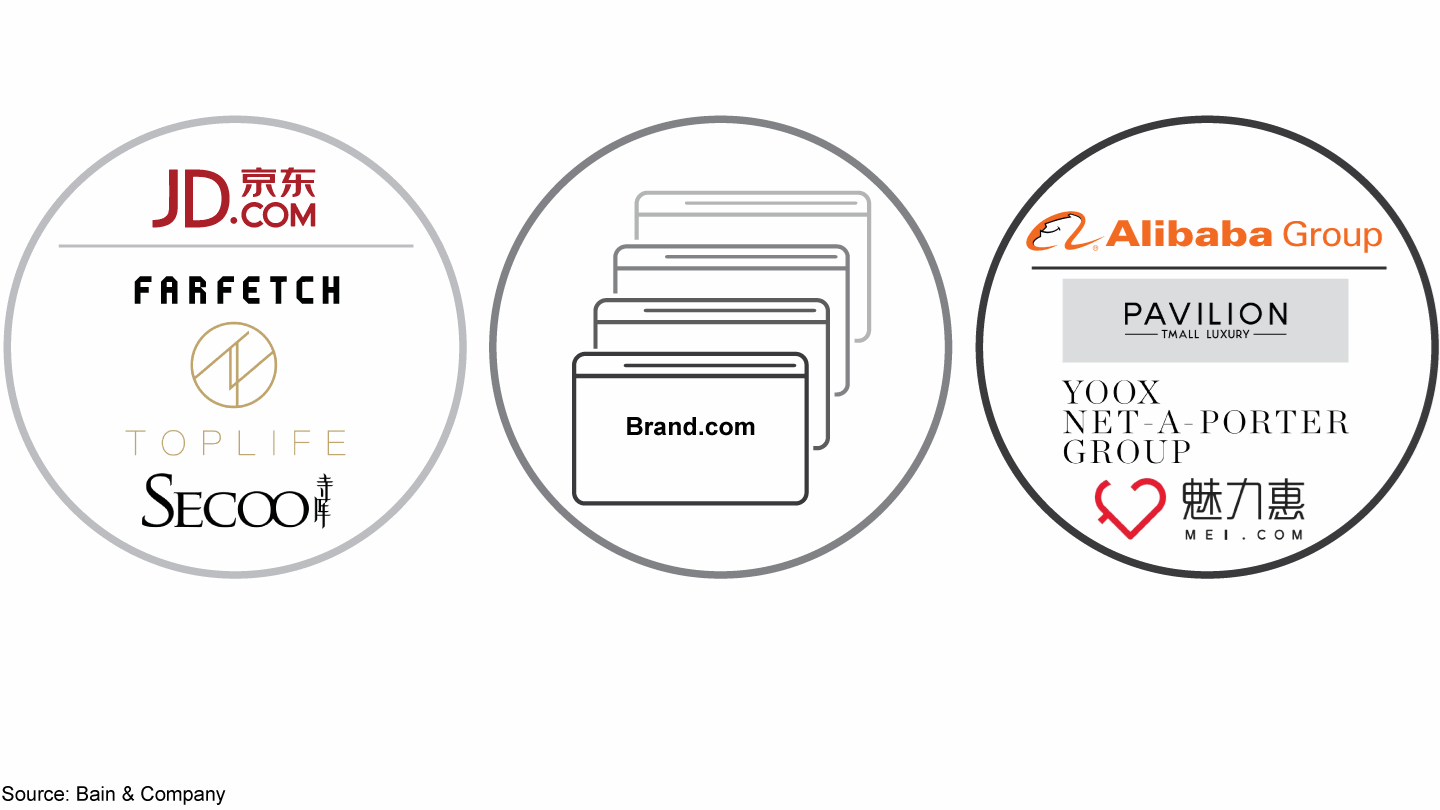
It is, after all, an omnichannel world. As each year passes, luxury brands learn more about how to integrate online and offline sales, how to use digital engagement campaigns to get customers into their stores and how to improve the in-store experience. Winning brands are taking these omnichannel lessons to heart. For instance, they are thoughtfully adjusting their physical footprint, with increasing emphasis on larger stores and like-for-like growth. The “Silk Mix” event by Hermès in Beijing was a great example of a true omnichannel initiative: an innovative combination of a pop-up store with a WeChat mini-program that increased traffic to the Hermès official account and attracted thousands of guests to the event.
Engine 4: A rapidly expanding middle class
Middle-class consumers will represent an estimated 65% of all Chinese households by 2027, according to research conducted by Bain & Company for the World Economic Forum. All signs point to a continuing rise in average per-capita income among China’s urban population. This expanding middle class continues to produce first-time buyers of luxury goods.
Why some luxury brands aren’t celebrating
While luxury sales are robust in China, not every brand executive feels euphoric. As their incomes rise, and as they spend more on luxury goods, Chinese consumers are becoming increasingly discerning. Some brands are more successful than others at serving these needs, resulting in a distinct polarization in luxury brands’ performance, similar to what we saw in 2017.
The reality is that some brands have done better for the second year in a row, and some have done worse for a second year. How dramatic is this division? Consider the top 20 luxury fashion and lifestyle brands by revenue. For every brand that grew by more than 25% in 2018, there were two brands that grew by less than 10% (see Figure 8).
Luxury brand performance varied in 2018, but outperformers followed several winning strategies
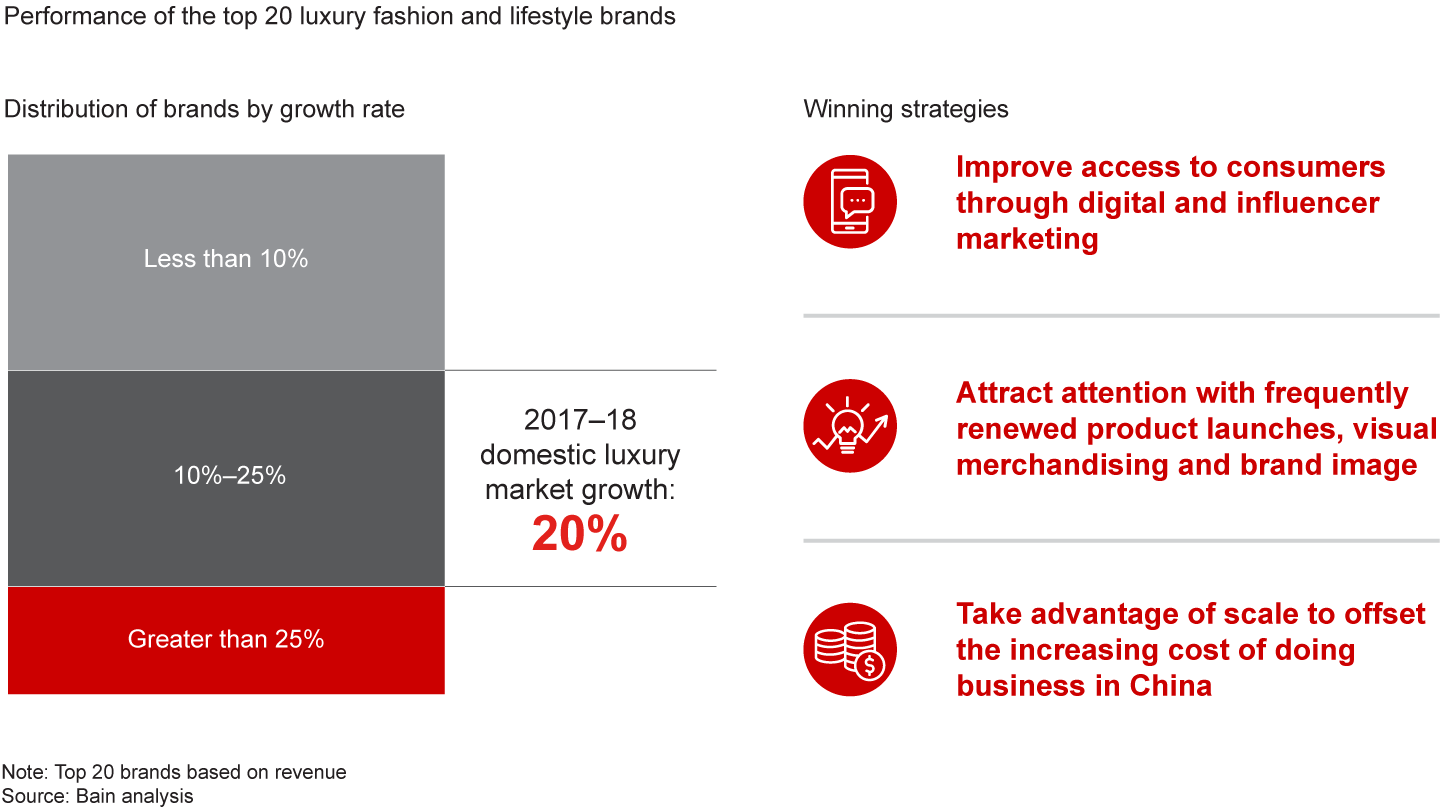
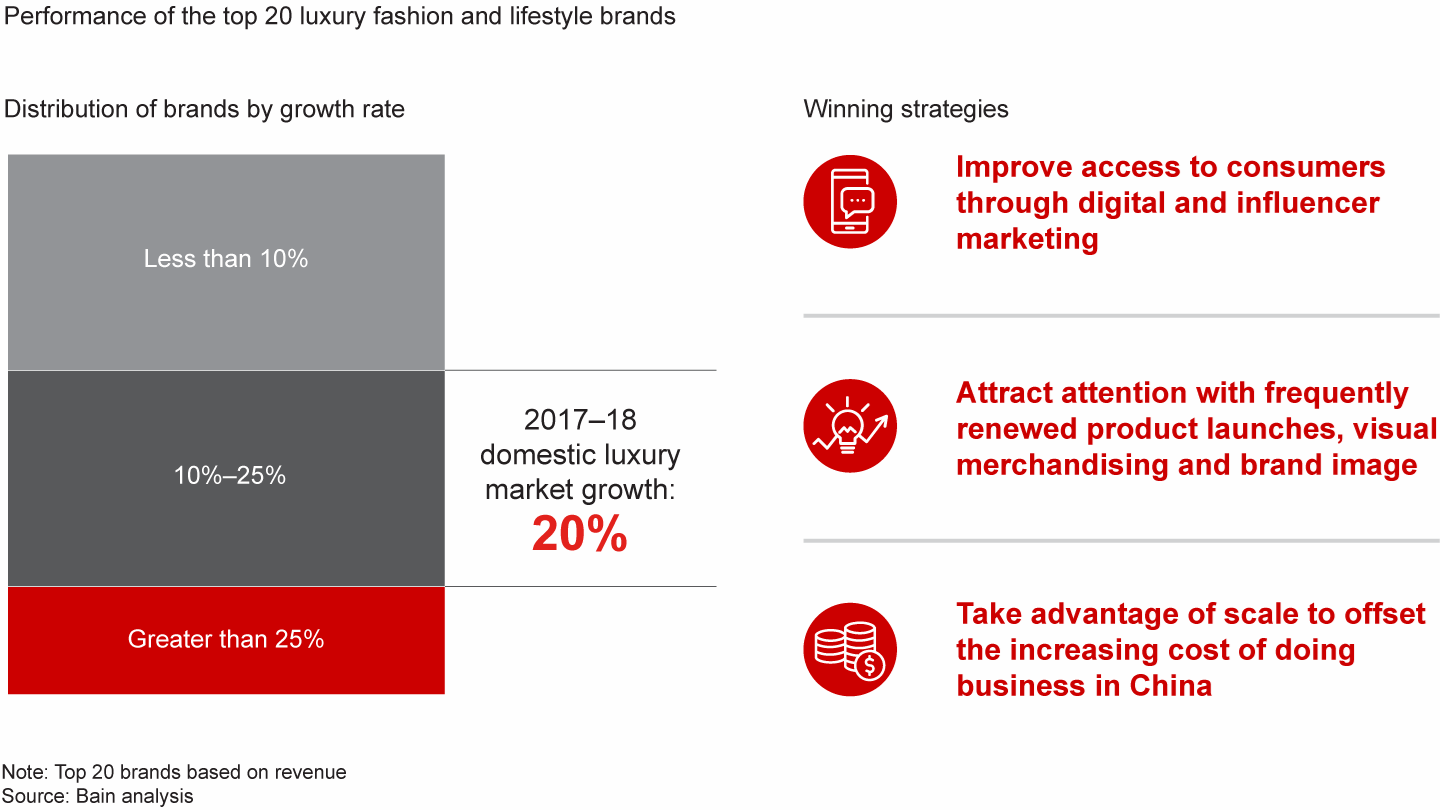
We looked deeper into the performance results to determine why some companies make such good progress while others lag. Among our findings: Winners strive to enhance their access to consumers through digital and influencer marketing, often attracting millennials with younger and more casual collections. Since 2015, the top 40 luxury brands in China have nearly doubled the portion of their marketing budget devoted to digital, spending between 40% and 70% of that on WeChat (see Figure 9). These leading brands use WeChat to identify and target consumers for online and offline sales (see Figure 10). For example, Estée Lauder consumers can use WeChat to book facial treatments, and Coach allows consumers to access coupons and manage their membership cards on the ubiquitous social media platform.
Brands are increasing their spending on various online and social media platforms, with many favoring WeChat
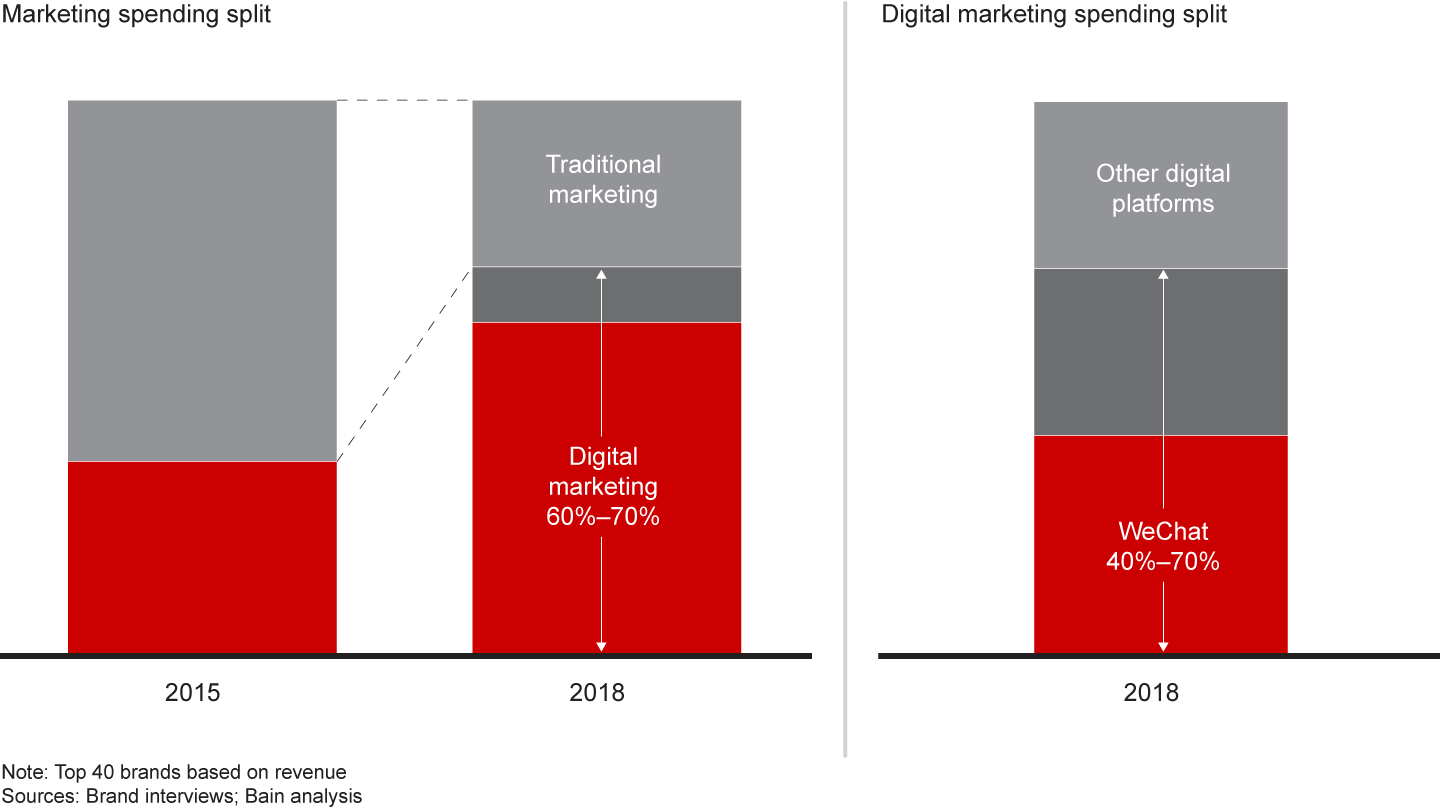
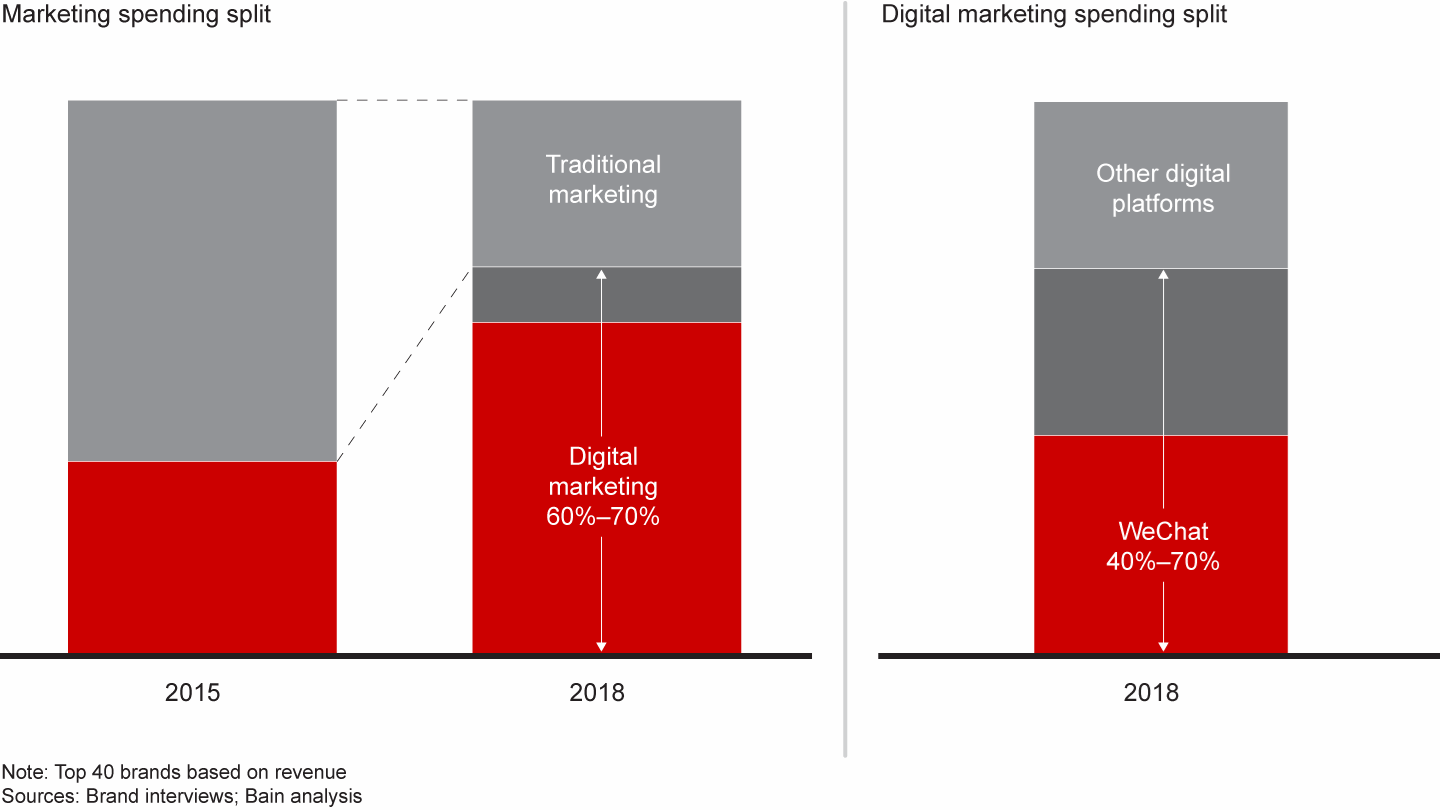
Brands use WeChat to identify and target consumers, eventually leading to both online and offline sales
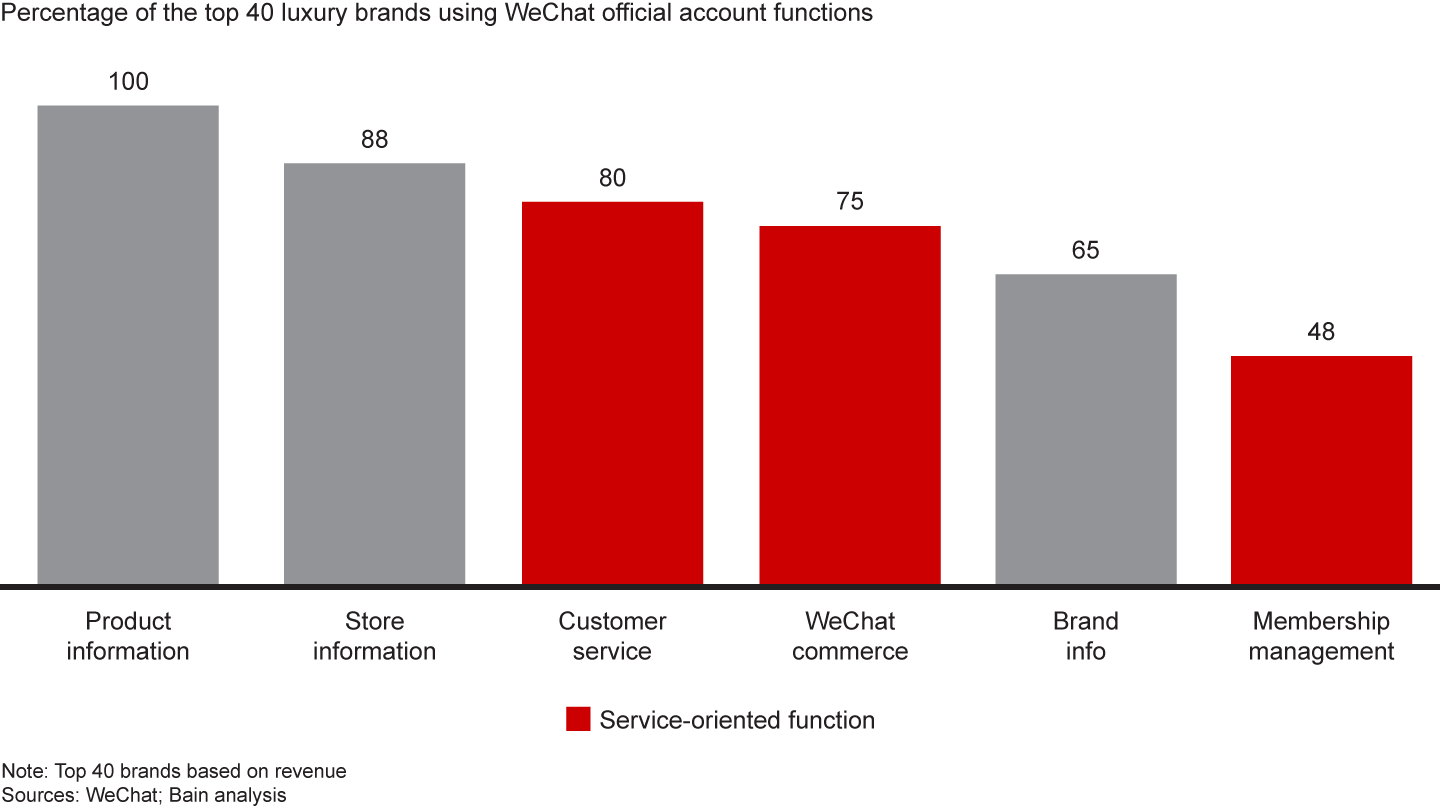
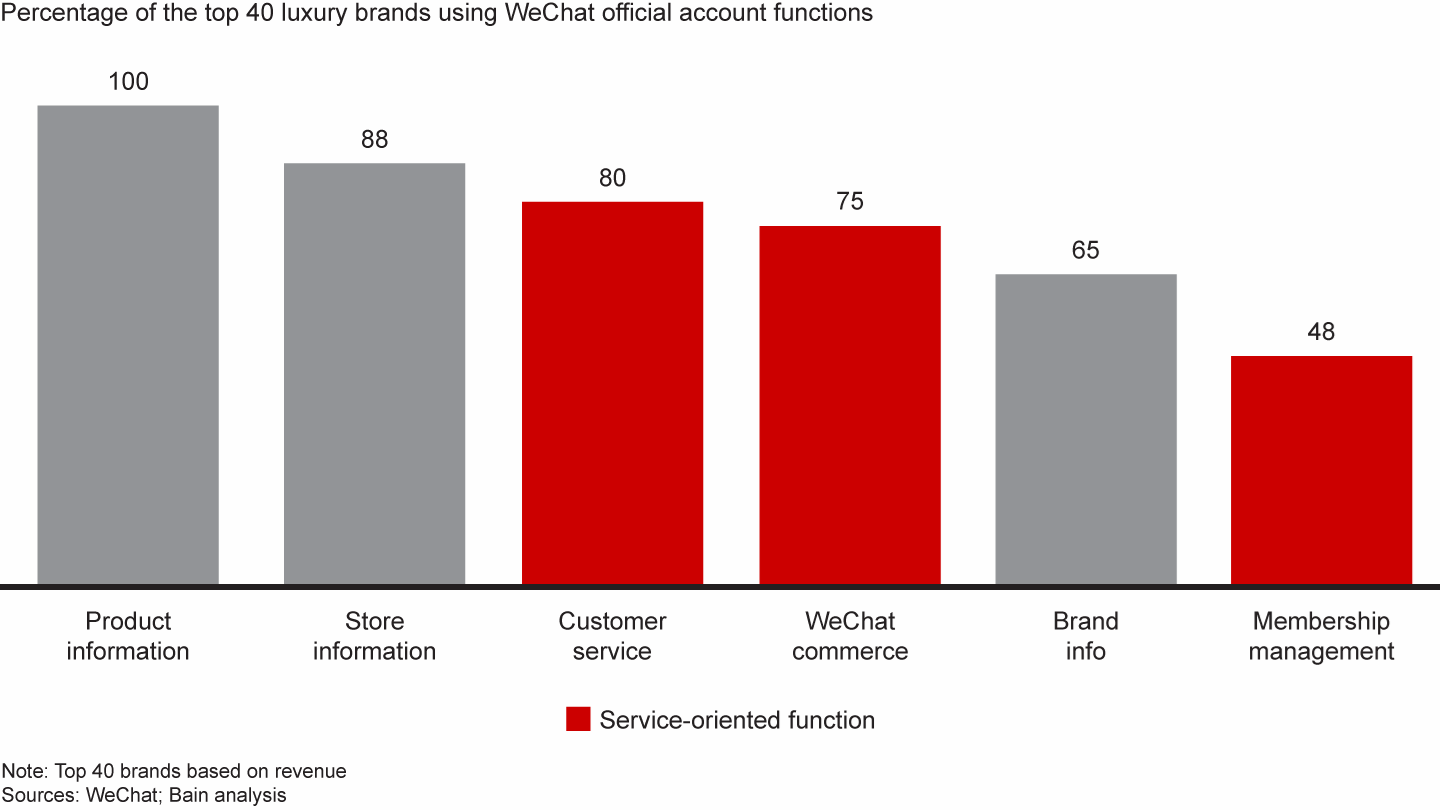
A second theme we identified among the winners was a focus on accelerating product launches and visual merchandising changes, moves that address millennials’ need for newness.
And there was a final differentiator: Many larger, more established brands benefited from their scale advantage. With everything from rents to salaries to marketing events and engaging key opinion leaders getting more expensive, the cost of doing business is rising in China. The trend tended to favor bigger brands in 2018.
Looking ahead
Turbocharged engines inevitably lose steam. China’s economic growth is slowing, albeit in a controlled manner. Real estate prices are likely to flatten, reducing the positive wealth effect on Chinese households.
Still, luxury brands can expect a promising year ahead in China. Luxury sales will remain healthy, though they are unlikely to keep pace with 20% growth. Growth in the low-to-mid teens seems more probable in 2019.
That expansion will result from the same positive forces that made 2017 and 2018 so strong. The Chinese government is expected to maintain its adjustment of import duties to encourage domestic consumption, as well as to reduce the VAT rate. It is also likely to continue imposing strict control over passengers and parcels at customs, and to more carefully supervise the army of “daigou agents” who purchase overseas for local consumers. And brands will continue to narrow the price gap with overseas markets.
China’s millennials will not lose their taste for luxury goods, nor their willingness to buy. A recent UBS survey found that 71% of millennials have a positive financial outlook, and 81% expect their income to increase. Meanwhile, China’s middle class will continue to expand.
The engines thrusting luxury goods sales in China may not be unstoppable. But they show no signs of stalling out.
This report was authored by Bruno Lannes, a Bain & Company partner based in Shanghai and a member of the firm’s Retail and Consumer Products practices.